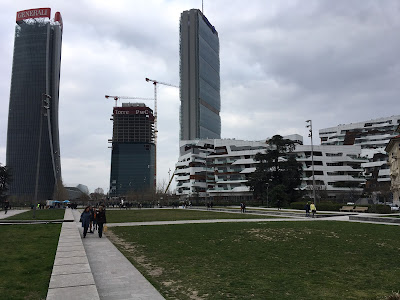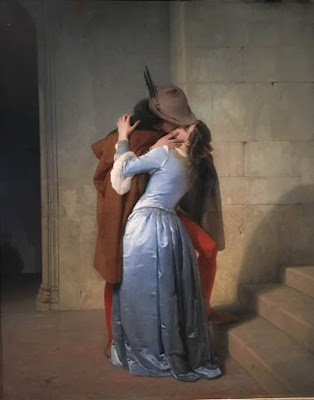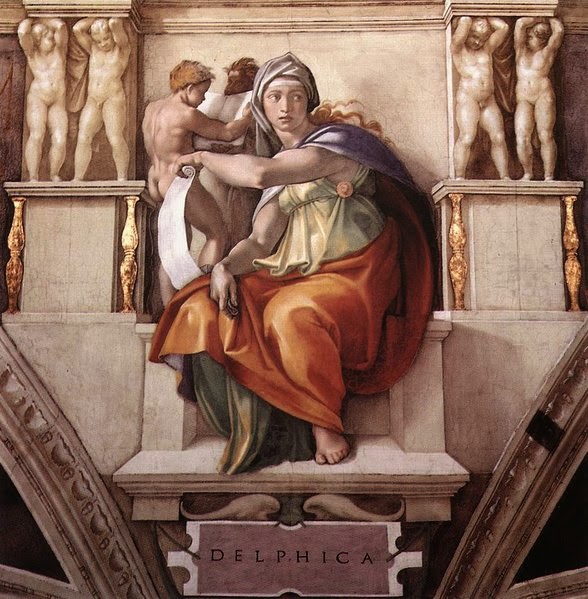In this blog I've covered past trips to Italy. This one is different. Since Gauss died last June, I've thought I should come back here, for several reasons. The first is to immerse myself in the language and force myself to speak it. Before he got sick, Gauss and I had planned to spend some time here after he retired. I'd been hearing him speak Italian with his parents for so long that I understood much of what I heard. But I've had difficulty generating speech on my own. He told me, "If you spent three to six months here, you'd be able to speak."
Well, Gauss is no longer with me. I don't have him to lean on, so it's up to me to get around. And I'm happy to report that I've managed. In the ten days since I arrived, I've become more confident (or maybe more desperate!) so I just launch in, knowing that my Italian is lousy. But people are understanding me.
 |
| Pasta with the Papagnos, first night here. |
 |
| Costanza had to replenish her parents' Nespresso supply. Since the Italians treat their coffee like a drug fix, it's only appropriate that they now have an automated way to count up the Nespresso pods and pay for them. |
|
I really like Italy and there are things about it that amuse me here. Cousin Costanza was in town for the first few days of my visit. Milan has improved even in the two years since I was here last. The city is cleaner, there are many new subway cars, and there is a welcome new development: Cars now stop for pedestrians in crosswalks. I am hesitant to start walking when a car is coming, but they always apply the brakes and look at me like I'm crazy for not stepping in front of them.
Costanza took me to a new development called City Life which adds some much-needed open space in Milan. One thing I love about Italy is the sense of design, and how well they integrate the very modern with the very old.
 |
| Open space at City Life |
 |
| With Costanza at ultra modern City Life |
 |
| The Vertical Forest condo building. It was here four years ago when I visited but now the trees are a lot bigger. There are some very old houses just to the right of these new condos, and it all works together. |
Part of the reason for my visit was sentimental. Milan was
Gauss's hometown and I wanted to go to places that had been important in
his life. My first stop was the Duomo. Gauss loved it and
I had to just sit and be with that thought for awhile.
There's something really moving about being inside...the hush, the
grandeur, all the work it represents. (Yeah, I know about the objections to the business that is the Catholic church, but still, it's a
hell of a building.)
 |
| Detail of the floor. All stone, cut and pieced together. |
 |
| Art and stained glass everywhere, at a scale that is hard to imagine |
I climbed the steps to the roof. It rained a bit the night before
and was windy so the air was crystal clear and the Alps were on
display.
 |
| I visited the Duomo on a day when the wind was blowing and the air was clear. The Alps were in view! |
 |
| The original family home in Milano is right downtown behind the Galleria. Now it is a boutique hotel. |
 | | | | |
| My sister Ginnie(on the right) joined me a few days later. She had to visit the top of the Duomo, too. |
|
|
|
|
|
|
|
Since this was Ginnie's first time in Italy, I had to take her to see Leonardo DaVinci's Last Supper. Many people don't realize that it's in Milan. I first saw it in 1981 when Gauss and I came to Italy for our first wedding anniversary. The only evidence of restoration that had just begun then some small light patches along the lower edge of the fresco. The restoration removed much of paint that had been added in previous restoration efforts, leaving only the remnants of DaVinci's original work of art. Since a good percentage of his original paint has flaked off in the 500 years that the painting has existed, what remains now has an ethereal, almost pointillist quality. Guides will explain that DaVinci used an experimental technique for the fresco, and the gossamer appearance of it conveys the piece's fragility in a way that words cannot.
 |
I had to take Ginnie to see Da Vinci's Last Supper, which is walking distance from Costanza's apartment where we stayed. This is what it looks like today, ethereal and almost pointillist.
 |
| Da Vinci's Last Supper in 1982 before restoration. |
|
 |
| I got here and found spring. Magnolias in bloom! |
 |
| And flowering crab! |
I spent five hours last Tuesday with Gauss's aunt Franca, who speaks NO English at all. I managed a running conversation with her the whole time, relying occasionally on Google Translate to convey more abstract topics. The conversation ranged from widowhood (her husband Emilio died some years ago), our families, cooking, and home renovation to urban renewal and the Japanese photography exhibit we saw together at a gallery. I dredged up words I didn't know I had, and murdered verb conjugations. She dumbed down her conversation to the level of a three year old. It worked.
 |
| Franca in her kitchen |
 |
| We stopped at an art gallery and book store. I made Franca pose with this book. |
I made an error when packing...forgot to bring any bras. So I managed to go to a lingerie shop, make my needs known, convey my size, and get fitted. I left with one of the more unusual souvenirs I've ever brought home from a trip. Ginnie loved my purchase and asked if I could take her to there too. So back we went. And now she has a fancy European undergarment as well. (No photos of this!)
There are other reasons I'm here. One, which I accomplished on March 22, was to return some of Gauss's and his father Aldo's ashes to a place they both loved. I had decided to take them to the little town of Mandello del Lario, north of Milan and Lecco on the shore of Lake Como. Gauss and I had been here together. My plan was to take the ferry boat from Lecco up to the town and then walk up the mountainside. Oh well, the best laid plans...
 |
| Found this sign on March 22, 2019. |
After flying from the US, scheduling and rescheduling my time in Italy
to accommodate many peoples' changing needs, and finally deciding on a
place and way to get the ashes to Mandello, this happened. The 23rd is
already booked. Fortunately there was a train that we could take to
Mandello. I had a laugh/cry moment when I saw this sign. If Gauss were still here, he would have laughed out loud.
I can't recommend our hotel in Lecco, Hotel Alberi, enough. It was reasonably priced (about 100 euros a night including breakfast), comfortable, spotlessly clean, an easy walk to the train station but overlooking the lake, and with the nicest inkeepers I've ever met. They were friendly and helpful, and Ginnie appreciated that they made her a custom cappuccino to go with her croissant.
 |
| Breakfast at the Hotel Alberi: capuccino (custom made decaf for me!), blood orange juice, a pistachio-cream filled croissant (turns out I didn't need the Nutella), salami, and slice of brie. |
 |
View from our balcony at the Hotel Alberi. Lake Como on the left. The only snag was traffic noise but it quieted down by 10 pm.
|
 |
| And there was a guy practicing tightrope walking in the park just below our balcony. |

Lecco
used to have a wall; now only remnants remain. But I always love a map.
Below: Bit of the city wall looking east toward the mountains; New
buildings and old city wall looking west toward the lake.
 |
| A bit of Lecco's old city wall, looking east toward the mountains. |
 |
| New apartments and old city wall, looking west toward Lake Como. |
|
 |
| In Mandello. Lovely lakeside town. |
 |
| Simple lunch in Mandello, but look at the fancy toothpick. |
 |
The interior of the old church just off the lake in Mandello
|
 |
| A flower shop we encountered as we walked up the hill in Mandello |
Gauss loved this town at the base of La Grigna, a peak he visited often as a child. For Aldo, this was a significant place because of his activities with the Resistance in World War II. Aldo worked in these hills and villages to smuggle Jews and other resisters out of Italy before taking refuge in Switzerland himself. So, joined by my sister Ginnie, I walked the foot paths through the town to a spot where we left their ashes. From there, one could see the mountains behind and the lake below.
 |
| Mandello has placed signs around the town commemorating events in the town's history. Many of them refer to the activities of people like Aldo, who as part of the Resistance in WWII, helped Jews and others escape fascist Italy for neutral Switzerland. |
|
|
 |
| Just to the left of this footpath is the spot where I put Gauss's and Aldo's ashes together. From there one can see the lake below and the mountains above. The spot also overlooks a nice vegetable garden where someone is growing some grapes as well. |
|
|
 |
| Here is the view up the hill from the spot where I placed the ashes. |
After our day in Lecco, we took the train to the Frisia family home in the little town of Merate, just a little south, where we had an amazing dinner with Gauss's cousin Donato, Donato's wife Anna, their daughter Elena, and Elena's son Luca Vianello. (Yes, yet another Luca in the family. Elena's brother is also a Luca.)
With Luca's good English, my crummy Italian, and more help from Google Translate, we had more conversation about family, food, (Luca says that I qualify as Italian because if you are talking about food when you are eating food, you are Italian) Brexit, Trump, and health care in America (they can't believe that people in the states can go bankrupt when they get sick.)
 |
| Left to right: Luca Vianello, Anna Frisia, Patti, Donato Frisia, Elena Frisia, Ginnie Isaacs Cover in Merate |
The other reason for my visit is that my kids are half Italian, and I want to maintain the ties between those of us in the States and the Italian relatives. Gauss used to be the one to do that. Now it's my job, and one I'm happy to take on. Although Ancestry says I'm only 1% Italian, the country and culture have become a significant part of me.
Italians know how to live. They build welcoming public spaces and good public transportation. They eat leisurely meals, dress well, and incorporate art and design into their everyday lives. While riding the subway, I looked around and thought, "Wow, these people are gorgeous!" I realized that they're not necessarily more attractive than Americans, it's just the more of them take time to fix their hair, trim their beards, and wear well-fitting clothing. Most homes have bidets in the bathrooms; like a little mini bathtub for your tushie. So civilized! We Americans could learn a thing or to from the Italians.
 |
| Square in the seaside town or Zoagli, where Gauss's aunt and uncle have a seaside apartment. |
Art and good design are everywhere, as are Catholic churches. I visited the Brera Museum, which has a huge collection of ecclesiastical art dating from the middle ages through the renaissance and beyond. Great stuff, but at the end I was delighted to discover the work of the artist, Francesco Hayez, whose paintings were a welcome break from altarpieces and the assumption of Mary.
 |
| Hayez' The Kiss, which caused a sensation when it first appeared. |
|
|
 |
| Hayez' second work entitled The Kiss, depicting a mother sending her son off to war. Sweet and moving. |
 |
| Hayez' Odalisque |
And last, for now, delicious food. I am bingeing on buffalo milk mozzarella because it's almost impossible to get in the states. Breakfast, lunch, and dinner!
 |
| Breakfast at Costanza's apartment including some buffalo milk mozzarella that I just couldn't stop eating. And blood orange juice. Yum. |
 |
| Lunch in Venice at Ristorante San Provolo, where I ate the amazing seafood pasta that Gauss had on our last trip. Ginnie wasn't adept at twirling spaghetti so she got something she could stab with a fork. It was really good, too! |
 |
| Squid ink spaghetti at Cafe des Arts in Murano. It was squiddy and delicious. |
 |
| Dinner special at Osteria ai 40 Ladroni, Venice. The pasta with shrimp was amazing and the teeny-tiny calamari—local to Venice—were even better. |
Ginnie and I finished our trip in Venice. Ginnie arranged for us to get a tour of the Jewish neighborhood, so we're staying in a hotel in the Canareggio neighborhood near the original Ghetto. The ghetto is very small—one little island and a street with a few kosher restaurants and bakeries.
 |
| The only buildings in Venice that are higher than 4-5 stories are in the ghetto. This is because Jews were confined to living only in this area (behind locked gates at night) so they had to build up instead of out. We weren't able to go into the building, but our guide told us that the ceilings are very low, unlike those in most Italian homes. |
 |
| The exterior of the old "German" or Ashkenazy synagogue in the Venetian ghetto. |
 |
| "Courtyard of the Crazy Stairs"—so named because the buildings were added onto in random fashion to accommodate a the growing population of a small area. |
 |
| Our guide inside the Ashkenazi synagogue, on the top floor of the Jewish museum in the old ghetto. It is no longer in use, and can only be seen when you take the tour. |
 |
| Inside the Sephardic synagogue, still in use today. Jews were only allowed to work as money lenders or sellers of used clothing; they were not allowed to be artisans. Therefore, the synagogues were designed and decorated in typical Venetian style by non-Jewish architects and craftsmen. |
 |
| Memorial to Venetian Jews who died in the holocaust. Barbed wire above is part of the memorial. |
 |
| The Corner Synagogue, from the street. Synagogues were always on the top floor of the building, because nobody could live above them. |
Venice is magical at night. I went for a walk near our hotel just to soak up the quiet. There are no cars here. All you hear is the sound of people's voices and the clatter of dishes at the restaurants.
 |
| Venice at Night |
 |
| Venice at twilight, just outside our hotel |
 |
| Venice at night |





















































Comments
It's important to find the joy in the sorrow. I'm thinking of Franca again and how you reconnected with her during your visit. Bravo for braving Italy alone and bravo for moving forward.